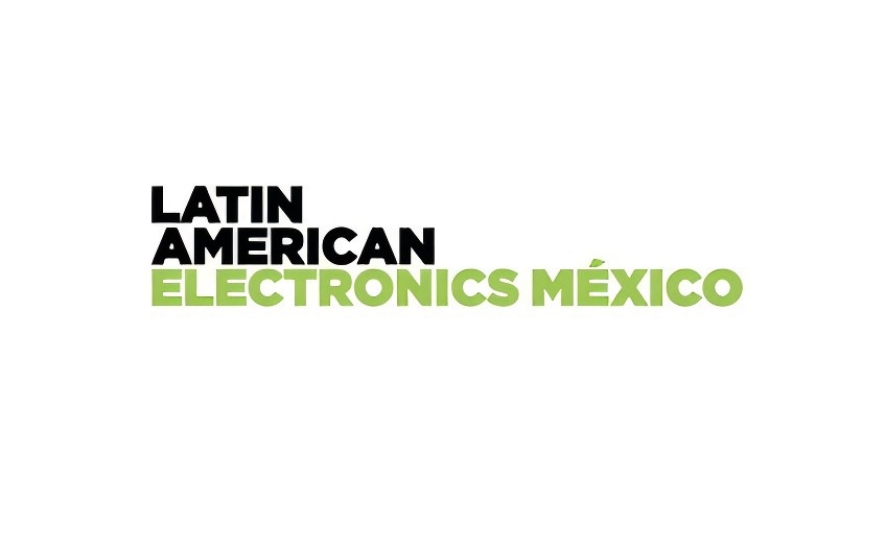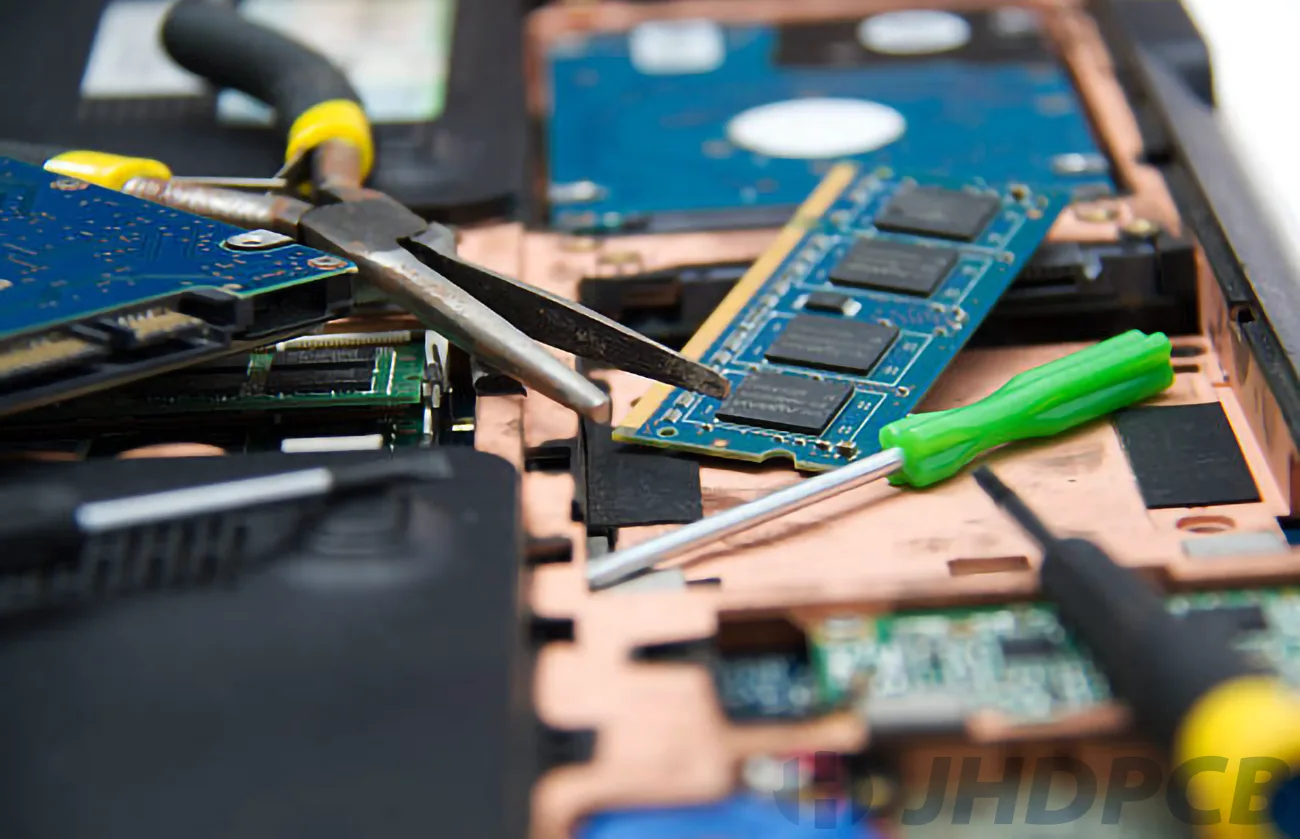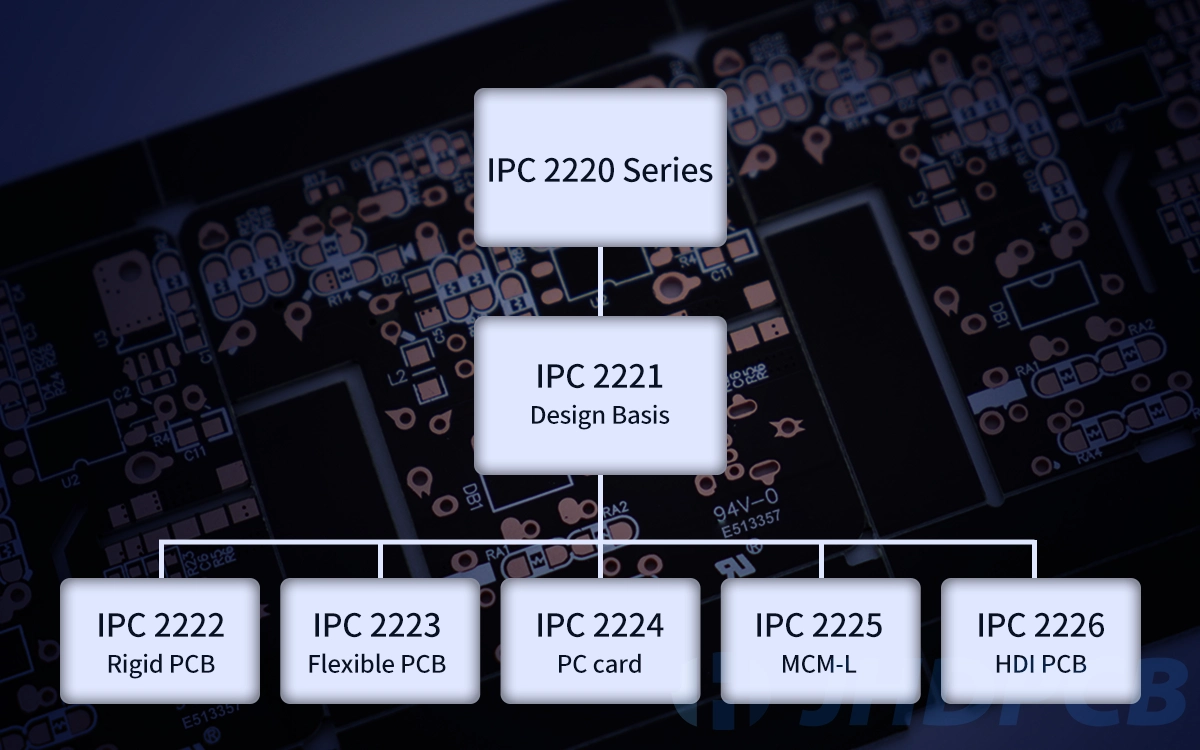Soldering Flux in PCB Production: The Ultimate Guide to Roles and Types.
jhdpcb@gmail.com
What is a soldering flux?
Flux for solder are chemicals used before and during electronic soldering flux. Many people want to know that what is soldering flux made of a base material (vehicle) and an activator. Fluxes can be used for manual or automatic soldering processes. Solder fluxes are mainly used to clean and prepare metal surfaces before soldering by removing oxides and impurities. Oxides are chemical compounds formed when metals are exposed to air. Oxides prevent the formation of perfect welds. The presence of metal oxides on a PCB can reduce electrical conductivity, resulting in inefficient current flow through the PCB and board. They also prevent reoxidation of the metal surface during soldering. In addition, fluxes allow the molten solder to form durable electrical and mechanical connections.
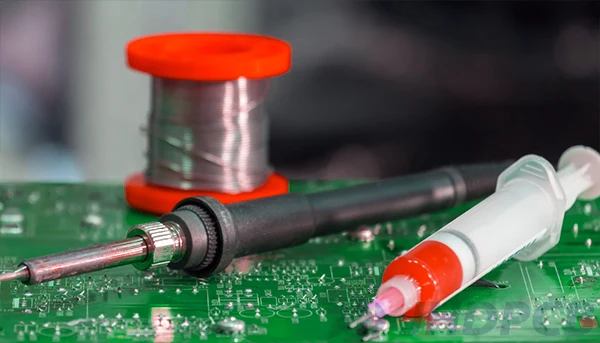
What is soldering flux paste?
Is soldering paste the same as solder flux? Nowadays, many people are still confused about the two terms solder paste and flux, here we will introduce soldering paste vs flux for you, but in fact, flux for soldering is a generic term and solder paste is a category that belongs to fluxes whose purpose is to increase the reliability of the solder and the object to be soldered during soldering, with wetting Among the main tasks of the action are oxidation, elimination of auxiliary heat transfer, reduction of metal surface tension, and beautification of the solder spot. Flux for soldering silver and aluminum soldering flux both are very important. Flux soldering in the welding process can aid and facilitate the welding process while providing protection against chemical oxidation reactions. Flux solder can be divided into solid, liquid solder flux and gaseous forms. Soldering paste flux, that is soldering with flux paste, is a new type of paste solder material, a mixture of solder powder, flux, other surfactants, and thixotropic agents. Soldering flux paste for electronics is very common in the industry. They are mainly used in the SMT industry to solder PCB surface resistors, capacitors, integrated circuits, and other electronic components.
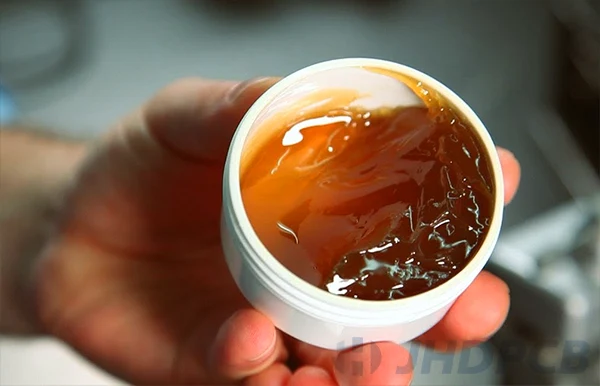
What is the role of flux in soldering?
Cleaning printed circuit boards and removing oxides and contaminants is the primary function or use of fluxes in printed circuit board assembly and processing. Oxides on the PCB can cause poor solder joints, poor conductivity, and current flow through the circuit. Fluxes improve soldering and wetting and deoxidize the metal (copper traces on PCBs and conductive traces in electronic components). Flux activators help wet the molten solder on mounting surfaces, component leads, and conductors, and remove oxides and other surface contaminants. To understand flux, you need to know its purpose. Like most things related to solder with flux, it starts with the wetting force. The flow of solder is called “wetting.” When solder flows over a surface, such as a component joint, that surface is “wetting.” If there is no flux, there is no wetting. What many call “cold solder” has nothing to do with the absence of heat, but simply the absence of wetting.
Wetting is determined by four natural forces, two of which oppose the flow of solder and are called “negative wetting forces.” These forces are as follows:
- Surface tension: atoms on the surface of the liquid are attracted to atoms in the liquid. Some liquids have very low surface tension, while others have high surface tension. To see the difference, pour alcohol (which has a very low surface tension) onto a non-porous surface such as glass. Then do the same with water (which has a very high surface tension). Alcohol tends to flatten and spread out easily, while water tends to delaminate. The surface tension of solder is much stronger than that of water (lead-free solder is stronger than lead solder), and the solder becomes ball-shaped (the famous “solder ball”). Surface tension is the strongest negative wetting force.
- Friction: the resistance that occurs when one object moves over the surface of another is called “static friction,” but friction also exists in liquids (“viscosity”). Both forces affect the wetting of the weld, but they are less important than surface tension.
- Gravity: Think of this force as a weight being pulled toward the ground. Gravity promotes wetting at and below the point of solder application (e.g., in a tinned hole in hand soldering) and prevents wetting above the point of solder application (vertical struggle with RTN filling in wave soldering).
- Atomic Attraction: This force is the attraction between the pure surface metal and the solder. Note the emphasis on pure (elemental) metals. Metal atoms with good conductivity are unstable and easily form compounds with other elements by exchanging electrons. The resulting compound has no reaction energy (usually called “passive”) and does not attract solder.
When solder is applied to a clean metal surface, a strong attraction occurs between the surface metal and the tin (solder) [1]. This attraction overcomes the negative wetting force so that the solder wets the pad, conductor, or PTH and runs off onto them. At the same time, chemical reactions between the tin and the surface metal produce compounds called intermetallic bonds. In the case of copper, the resulting intermetallic compound consists of three copper atoms and one tin atom (i.e., Cu3Sn) and has a melting point of 676 °C [2].
What are the common types of soldering flux?
There are three main types of soldering flux for the electronics industry. An overview of each is provided below.
| Types | Features | Application |
|---|---|---|
| Rosin soldering flux | It is the oldest type of fondant. It is made from a natural resin obtained from pine trees. Modern rosin-based fluxes are mixed with other fluxes to make them more efficient. This type of flux is easier to process, especially at high temperatures. | The flux removes both metal oxides and foreign matter. Resin flux is acidic, but when it solidifies, it becomes inert and can stay on the weld surface without damaging the contours. It is recommended that the flux be removed after welding, as the contours can become hot and the flux can liquefy. |
| Organic acid flux | Also called water-soluble flux. These fluxes are made from organic acids such as citric, lactic and stearic acids. Water soluble fluxes are made by combining these acids with organic solvents such as alcohol or isopropyl. | Organic acid-based fluxes are effective in removing metal oxides. They also have high soldering activity and are easy to clean. Organic acid-based fluxes should not be left on solderable surfaces, especially circuit boards. Organic acid-based fluxes are mainly used for soft soldering. |
| Inorganic acid flux | They are strongest corrosives, they consist of chlorinated acids produced by the addition of ZnCl2, NH4Cl, HCl etc. and are active from room temperature to 300-400°C. | It is best suited for solid metals such as brass and copper as well as stainless steel. Before using inorganic fluxes, the soldering surface must be cleaned and freed from corrosive residues. So to clean flux residue after soldering is important. Finally, inorganic acid fluxes can be used for electroless soldering. |
| No-clean flux | Chlorine-free fluxes can be based on natural or synthetic rosin. Rosin-based no-clean fluxes are essentially the same as rosin-based fluxes (type R), but usually contain much lower concentrations of natural rosin than those used in type R flux solutions (R, RMA, RA). True no-clean synthetic fluxes contain synthetic resins that give the flux the same desirable properties as natural rosin products. No-clean flux solutions may also contain activators, the residues of which can cause corrosion. | No-clean fluxes are designed to help PCB manufacturers save time and money when cleaning PCBs after soldering. Compared to conventional R-type fluxes, they leave very little residue that normally does not affect PCB performance or cause long-term failures due to corrosion. |
| Water-soluble flux | Acid activators commonly used for water-soluble currents include organic acids, halogenated (including chlorine and bromine) compounds, amides, and organic salts of monobases and dibases. All of these activators are corrosive and must be removed from PCBs to ensure long-term reliability. | Water-soluble fluxes are very aggressive cleaners and oxidizers. They are more reactive than non-cleaning fluxes and have a higher cleaning power. |
How to use solder flux when soldering electronics?
Application of Flux.
According to IPC standard J-STD-004B, fluxes used for soldering electronic equipment are classified into three types. They are as follows. Rosin and rosin substitutes, water-soluble and non-detergent. Within these categories, there are fluxes of different types and chemical composition, depending on the requirements of the components and PCBs to be soldered. Depending on the automated soldering process used by the contract manufacturer, flux is applied according to the following methods
- Wave Soldering: fluxes used for wave soldering usually contain more solvents than fluxes for other applications and are sprayed onto the PCB before passing through the solder wave. After application, the flux cleans the components to be soldered, removing any oxide film that has formed. If a less corrosive type of flux is used on the PCB, the PCB must be cleaned before the flux is applied.
- Solder Reflow: a paste consisting of a sticky flux and small metal solder balls is used on PCBs that undergo a soldering process. This solder paste holds the component in place until the solder particles begin to melt when exposed to the heat of the oven. The flux not only cleans the metal surface, but its paste properties also interrupt the air supply and prevent further oxidation. The flux in the solder paste also contains additives that improve solder flux during melting.
- Selective Soldering: the fluxes used in selective soldering are applied by spray or more precise water-jet methods.
The method of flux application in these welding processes is carefully controlled to ensure that the flux can do its job without compromising the integrity of the welding process. For example, problems can occur if the flux heats up too quickly when solder pastes with high solvent concentrations are used. The heated solvent can leak out, creating cavities in the solder joint or splattering the molten solder onto parts of the PCB that should not be soldered. For this reason, the solder flux process is carefully controlled during preheating, temperature maintenance, and soldering.
Flux application steps.
Fluxes are available in paste form in small bottles and flux soldering liquid can form in cans, bottles, or flux pens. Liquid soldering flux are very important in many aspects. Organic fluxes are usually used for soft soldering, but inorganic fluxes can also be used for nonelectrical applications. Fluxes commonly used for soldering are inorganic, but they can also contain organic compounds that are activated at high temperatures.
The following sections describe the use of fluxes for soldering:
- Before using flux, clean the metal contact area with a good quality solvent to remove dust, dirt and excessive oxidation.
- The flux should be applied evenly to the surface to be welded. However, it should not be heated at this stage.
- When the soldering iron tip is hot, apply it to the metal contact applied with the flux. The flux should melt and spread over the metal surface, allowing the oxide film to be removed in the absence of flux.
- once the flux has evaporated, it is necessary to insert and melt a solder wire to ensure that the solder is bonded before it re-oxidizes, thus ensuring effective soldering wire flux.
Necessary safety measures when welding.
There are several very important safety precautions when welding. We will now present these measures one by one.
- Work in a safe place:
Before welding, welders should inspect their surroundings and work environment. It is advisable to pay attention to whether there is flammable equipment or materials near the welding area. A safe distance from the welding area is 10 meters. If the object to be welded or cut cannot be easily moved, JHD recommends keeping flammable materials away from the welding area. - Protect yourself from fire hazards:
If all fire hazards cannot be eliminated, appropriate safety measures should be taken to protect against flammable objects that cannot be relocated and to limit the heat, sparks, and hot slag generated during welding. - Consider the risks:
There are a number of risks associated with welding, most of which are health hazards (e.g., exposure to smoke and ultraviolet radiation). Since the risks associated with welding vary from job to job, it is recommended that you conduct a risk assessment before you begin work. This will determine control measures to control or eliminate the risks. Otherwise, welding or cutting should not be authorized. - Equipment maintenance:
Welders or helpers working on platforms, scaffolds, or catwalks should be protected from falling by guardrails, safety belts, life vests, or other protective equipment of equivalent effectiveness. Welders should locate welding cables and other equipment away from walkways, stairs, and steps. - Protect yourself with the right PPE:
Welders should always wear the right PPE to protect themselves from hazards that could lead to physical injury or illness. Here are some examples of PPE welders should wear: Long-sleeved shirts, Long pants with no cuffs, Welding helmet or goggles, Respirators, Ear muffs/plugs, Boots & gloves. - Take care of ventilation:
Proper ventilation is another means of preventing welding accidents and protecting workers. The main purpose of ventilation is to remove air pollutants from the workplace, prevent the accumulation of flammable or combustible gases and vapors, and avoid an over- or under-oxygenated atmosphere. - Protection from vapors and gases:
Local exhaust ventilation or general ventilation systems shall be planned and arranged so that toxic vapors, gases, and specks of dust are below the maximum allowable concentration. If necessary, welders shall use respirators to protect against inhalation of toxic substances. - Protection of other workers:
Welders should mark hot metal or have other means to alert other workers when welding work is complete. - Apply safety procedures:
Hold yourself and your employees accountable for following safety procedures. Report safety violations for yourself and for other workers in the same workplace.
How to clean the soldering flux of electronic products?
Isopropyl alcohol to remove flux:
Rosin-based flux is the most commonly used flux for soldering electronics. Fluxant residues can be removed with an isopropyl alcohol (IPA) solution. The solution should have a concentration of at least 90%. Always wear latex gloves and safety glasses when handling isopropyl alcohol. Ensure good ventilation in the work area.
- Use a clean brush. Use soft, smooth brushes. Toothbrushes and acid brushes can be used.
- If you have a spray gun, you can spray the alcohol solution on the solder plate.
- Dip the brush into the alcohol. Start brushing. Press gently so as not to disturb the solder joint.
- Wipe the plate to remove excess solvent. You can use a clean, dry cloth or toilet paper; do not use anything that leaves fibers or lint on the PCB.
Alternatively, you can apply an aerosol flux cleaner. Then remove flux residue with a brush as you would with an alcohol solution. Repeat the spray application to wash off the “waste” PCB material. Blow dry with hot air if necessary.
Removal of Water Soluble Flux:
Water soluble flux is an aggressive cleaner. It provides excellent soldering results, but it comes at a price. Its residues are very corrosive and must be completely removed.
Water-soluble flux is designed to be rinsed off with hot water. A saponifier can be added to make the removal process easier. Saponifiers are alkalis. They react with acidic residues on the plate to form soap and glycerin. This makes it easier to rinse off with hot water.
There is no doubt that flux for electrical soldering is very important. Electrical soldering flux helps clean and remove metal oxides from the surfaces being soldered. Flux also helps prevent oxidation of the metal surface during soldering.
If you have any questions, please feel free to contact us, JHD PCB will provide you professional service, contact us for more PCB knowledge.

